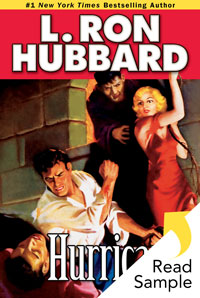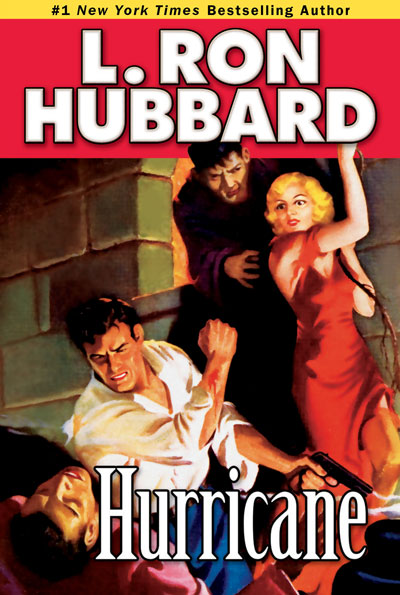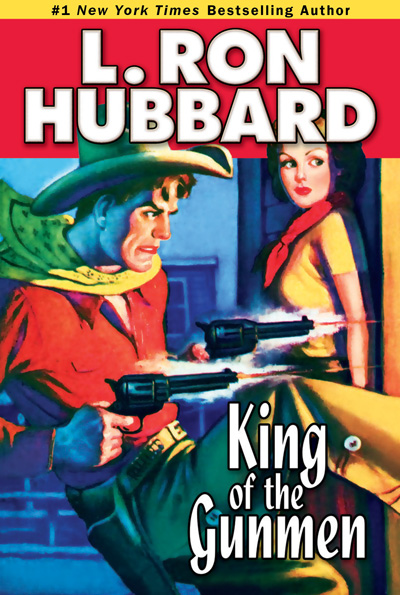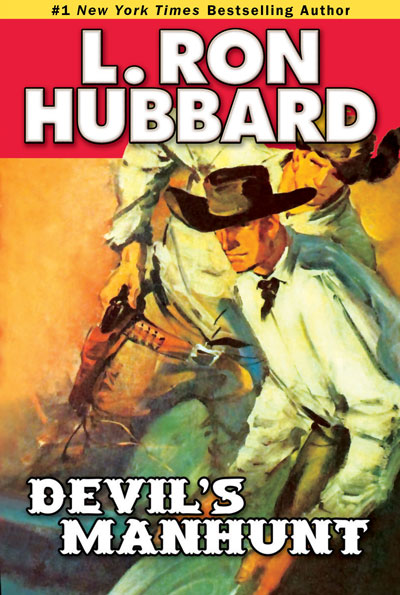Wrongfully accused, Captain Spar has been condemned to suffer the brutality of the guards and the conditions on Devil’s Island. But they haven’t broken his will, and now, escaping, he has one mission in life: revenge. Spar’s out to kill the man who put him into the devil’s hands. But he’ll have to take on a gallery of rogues who are as treacherous as the waters of the Caribbean.
The pressure is rising and a storm is brewing. But even in the face of a natural disaster, Spar discovers that nothing is more volatile than human nature—as temptation and danger are about to collide with Hurricane force.
“Hurricane will keep you on the edge of your seat from beginning to end as it unfolds.” —Mommy’s Favorite Things
* An International Book Awards Finalists
SAMPLE

ABOUT THE AUTHOR
In 1937, L. Ron Hubbard wrote to one of his editors: “You might have noticed that I am intensely wary of becoming any kind of a story specialist. I have sold the gamut of types: air war, air, western, detective, love, terror. My one passion is to build a name for variety. I like my freedom. I fight hard for independent individualism. I love to tie into a yarn and make it blaze in print.” L. Ron Hubbard’s passion for writing, creativity, and individualism certainly blazes across the page in stories like Hurricane.
Hurricane Glossary
Stories from the Golden Age reflect the words and expressions used in the 1930s and 1940s, adding unique flavor and authenticity to the tales. While a character’s speech may often reflect regional origins, it also can convey attitudes common in the day. So that readers can better grasp such cultural and historical terms, uncommon words or expressions of the era, the following glossary has been provided.
Atlas Mountains: a mountain range in northwest Africa extending about fifteen hundred miles through Morocco, Algeria and Tunisia including The Rock of Gibraltar. The Atlas ranges separate the Mediterranean and Atlantic coastlines from the Sahara Desert.
Barbary Coast: the term used by Europeans, from the sixteenth until the nineteenth century, to refer to the coastal regions in North Africa that are now Morocco, Algeria, Tunisia and Libya. The name is derived from the Berber people of North Africa. In the West, the name commonly refers to the pirates and slave traders based there.
Berbers: members of a people living in North Africa, primarily Muslim, living in settled or nomadic tribes between the Sahara and Mediterranean Sea and between Egypt and the Atlantic Ocean.
binnacle: a built-in housing for a ship’s compass.
blighter: a fellow, especially one held in low esteem.
bosun: a ship’s officer in charge of supervision and maintenance of the ship and its equipment.
Brobdingnagian: of or relating to a gigantic person or thing; comes from the book Gulliver’s Travels of 1726 by Jonathan Swift, wherein Gulliver meets the huge inhabitants of Brobdingnag. It is now used in reference to anything huge.
Colt .45: a .45-caliber automatic pistol manufactured by the Colt Firearms Company of Hartford, Connecticut. Colt was founded in 1847 by Samuel Colt (1814–1862), who revolutionized the firearms industry.
Devil’s Island: an island in the Caribbean Sea off French Guiana and location of a notorious French penal colony, opened in 1854 and closed in 1946. Used by France, its inmates were everything from political prisoners to the most hardened of thieves and murderers. Conditions were harsh and many prisoners sent there were never seen again. Few convicts ever managed to escape.
djellaba: a long loose hooded garment with full sleeves, worn especially in Muslim countries.
dodger: a canvas or wood screen to provide protection from ocean spray on a ship.
fathom: a unit of length equal to six feet (1.83 meters), used in measuring the depth of water.
Fort-de-France: the capital and largest city of Martinique, on the western coast of the island.
Franzawi: (Arabic) Frenchman.
French Guiana: a French colony of northeast South America on the Atlantic Ocean, established in the nineteenth century and known for its penal colonies (now closed). Cayenne is the capital and the largest city.
gangway: a narrow, movable platform or ramp forming a bridge by which to board or leave a ship.
gendarme: a police officer in any of several European countries, especially a French police officer.
gingham dog and the calico cat: reference to a poem called “The Duel” by Eugene Field (1850–1895) about a gingham dog and a calico cat (both stuffed toys) who fought until they had eaten each other up and there was nothing left.
G-men: government men; agents of the Federal Bureau of Investigation.
hard-boiled: tough; unsentimental.
hawse: hawse pipe; iron or steel pipe in the stem or bow of a vessel, through which an anchor cable passes.
hein?: (French) eh?
hooker: an older vessel, usually a cargo boat.
knot: a unit of speed, equal to one nautical mile, or about 1.15 miles, per hour.
la Légion: (French) the Legion; the French Foreign Legion.
lay to: to put a ship in a dock or other place of safety.
Legionnaire: a member of the French Foreign Legion, a unique elite unit within the French Army established in 1831. It was created as a unit for foreign volunteers and was primarily used to protect and expand the French colonial empire during the nineteenth century, but has also taken part in all of France’s wars with other European powers. It is known to be an elite military unit whose training focuses not only on traditional military skills, but also on the building of a strong esprit de corps amongst members. As its men come from different countries with different cultures, this is a widely accepted solution to strengthen them enough to work as a team. Training is often not only physically hard with brutal training methods, but also extremely stressful with high rates of desertion.
Mannlicher: a type of rifle equipped with a manually operated sliding bolt for loading cartridges for firing, as opposed to the more common rotating bolt of other rifles. Mannlicher rifles were considered reasonably strong and accurate.
Martinique: an island in the eastern Caribbean; administered as an overseas region of France.
mestizo: a racially mixed person, especially in Latin America, of American Indian and European (usually Spanish or Portuguese) ancestry.
metal: mettle; spirited determination.
Monsieur: (French) Mr.
Moorish barb: a desert horse of a breed introduced by the Moors (Muslim people of mixed Berber and Arab descent) that resembles the Arabian horse and is known for speed and endurance.
Moroccan: of Morocco, a country in North Africa. It has a coast on the Atlantic Ocean that reaches past the Strait of Gibraltar into the Mediterranean Sea.
m’sieu: (French) Mr.
old, my: used as a term of cordiality and familiarity.
Paramaribo: the capital and largest city of Dutch Guiana (now Suriname) in northern South America on the Atlantic Ocean.
patois: a regional form of a language, especially of French, differing from the standard, literary form of the language.
put in: to enter a port or harbor, especially for shelter, repairs or provisions.
Qu’est-ce que c’est?: (French) What is that?
reduction gear: a set of gears in an engine used to reduce output speed relative to that of the engine while providing greater turning power.
rhum vieux: (French) aged rum; rum that has aged at least three years.
rudder: a means of steering a boat or ship, usually in the form of a pivoting blade under the water, mounted at the stern and controlled by a wheel or handle.
Scheherazade: the female narrator of The Arabian Nights, who during one thousand and one adventurous nights saved her life by entertaining her husband, the king, with stories.
schooner: a fast sailing ship with at least two masts and with sails set lengthwise.
scuppers: openings in the side of a ship at deck level that allow water to run off.
seacocks: valves below the waterline in a ship’s hull, used for admitting outside water into some part of the hull.
Shilha: the Berber dialect spoken in the mountains of southern Morocco.
six strength: a wind strength with large waves and foam crests, some spray and winds at 25–31 miles per hour, as classified on the Beaufort scale created in 1805 by Sir Francis Beaufort.
slop chest: locker or chest containing a supply of clothing, boots, tobacco and other personal goods for sale to the crew of a ship during a voyage.
Snider: a rifle formerly used in the British service. It was invented by American Jacob Snider in the mid-1800s. The Snider was a breech-loading rifle, derived from its muzzle-loading predecessor called the Enfield.
superstructure: cabins and rooms above the deck of a ship.
telegraph: an apparatus, usually mechanical, for transmitting and receiving orders between the bridge of a ship and the engine room or some other part of the engineering department.
tender: a small boat used to ferry passengers and light cargo between ship and shore.
three sheets to the wind: in a disordered state caused by drinking; intoxicated. This expression is generally thought to refer to the sheet (a rope or chain) that holds one or both lower corners of a sail. If the sheet is allowed to go slack in the wind, the sail flaps about and the boat is tossed about much as a drunk staggers. Having three sheets loose would presumably make the situation all the worse.
transom: transom seat; a kind of bench seat, usually with a locker or drawers underneath.
weigh anchor: take up the anchor when ready to sail.
wing: bridge wing; a narrow walkway extending outward from both sides of a pilothouse to the full width of a ship.












